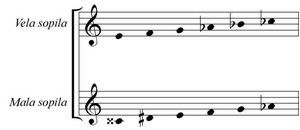Inscription 2009 (4th session) | Reference 231 | |
 | ||
Region Europe and North America | ||
"Istrian scale" refers both to a "unique" musical scale and to the Istrian and Kvarnerian folk music genres which use the scale. It is named for the Istrian peninsula. Genres include kanat and tarankanje; techniques include nasal tone, variation and improvisation, and resolution to the unison or octave; and instruments include sopele shawms, bagpipes, flutes, and tambura lutes. It was first named by Ivan Matetić Ronjgov early in the twentieth century, assisting his study and notation of Croatian music.
Description
Non-equal-tempered, the scale could approximately be notated as: E-F-G-A♭-B♭-C♭ [hexatonic] (see: enharmonic), the first six notes of an octatonic scale on E. It may be thought of in various ways, such as the Gregorian Phrygian mode with lowered 4th, 5th, and 6th degrees (on E: E-F-G-A♭-B♭-C♭-D [heptatonic]). Performances feature diaphony and the Phrygian cadence (in E: F and D moving to E).
Though, "relative intonation var[ies] considerably from example to example [and between instruments]," the scale has also been described as derived from just intonation: subharmonics seven to fourteen.
In Haydn's String Quartet in F minor, Op. 20 No. 5, something like the Istrian mode, but without its top note, is found. Uroš Krek's Inventiones ferales (1962) uses the scale, "in a disguised manner". Tartini may have studied the scale, and Bartók took note of the scale. Karol Pahor's cycle of 15 pieces, Istrijanka (1950), was the result of study of the Istrian mode, as was Danilo Švara's Sinfonia da camera in modo istriano (1957).
